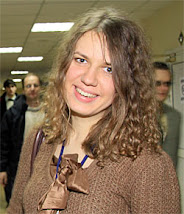10 July 2010, Kuala Lumpur – Here is an interesting news article from the Huffington News Portal on the World Open in the U.S.A. where Viktor Laznicka won the chess tournament. In one of his games against IM Bryan Smith, a see-saw battle ensued, ending with a great win for Viktor. You may the read the article below.
“On his first journey to America, Viktor Laznicka won the traditional World Open at Valley Forge, Pennsylvania, and the $20,000 first prize on Monday. Grabbing pawns and sacrificing Exchanges (rooks for light pieces), the 22-year-old Czech grandmaster showed a great fighting spirit and was very comfortable on his risky path to victory. He played the Swiss open strategy to perfection. With a rocket start, winning the first six games, he coasted to victory with three draws. Laznicka scored 7,5 points in nine games, edging grandmasters Pentala Harikrishna of India, Ilya Smirin of Israel and Luke McShane of England by a half point.
Played over the Independence Day weekend, the World Open is the premier open tournament in the United States. It attracted nearly 1200 players this year, competing in 10 sections. The top Open section with 119 players included 35 grandmasters.

Laznicka played his most dramatic game against IM Bryan Smith, who won the Philadelphia International tournament just prior to the World Open. It was a see-saw battle in the Sicilian Najdorf with Smith sacrificing a pawn for powerful pressure. The Czech GM didn't back off with the black pieces and accepted every challenge thrown at him. What began as innocent firecrackers quickly turned into a mine field where every step could have been the last. It was a great game for the spectators, watching both Kings under fire. Each player had a few chances to win the game and Smith was the last to err. The win was encouraging for Laznicka. He began playing with a lot of energy, kept winning and never looked back.
Laznicka played his most dramatic game against IM Bryan Smith, who won the Philadelphia International tournament just prior to the World Open. It was a see-saw battle in the Sicilian Najdorf with Smith sacrificing a pawn for powerful pressure. The Czech GM didn't back off with the black pieces and accepted every challenge thrown at him. What began as innocent firecrackers quickly turned into a mine field where every step could have been the last. It was a great game for the spectators, watching both Kings under fire. Each player had a few chances to win the game and Smith was the last to err. The win was encouraging for Laznicka. He began playing with a lot of energy, kept winning and never looked back.
Smith - Laznicka
1.e4 c5 2.Nf3 d6 3.d4 cxd4 4.Nxd4 Nf6 5.Nc3 a6 6.Bg5 (One of the most critical lines against the Sicilian Najdorf is making a comeback.) 6...Nbd7 (A fresh recent trend to replace the usual 6...e6.) 7.f4 (The main variation used to be 7.Bc4 Qa5 8.Qd2 e6 9.0-0-0 b5 10.Bb3 Bb7 11.Rhe1 and here some American players, led by GMs Sammy Reshevsky and Bill Lombardy, turned the long castle 11...0-0-0 into a short one by shifting the King and the Rook one square. For example, the game Westerinen-Lombardy, Helsinki 1961, continued: 12.a3 Be7 13.Kb1 Kb8 14.f3 Rc8 15.Ba2 Rhd8 and black was ready for the middlegame battle. Different approach is sought today: 7.Bc4 Qb6 8.Bb3 e6 9.Qd2 Be7 10.0-0-0 Nc5; or 7...e6 8.Bb3 Nc5 with a playable game.)
1.e4 c5 2.Nf3 d6 3.d4 cxd4 4.Nxd4 Nf6 5.Nc3 a6 6.Bg5 (One of the most critical lines against the Sicilian Najdorf is making a comeback.) 6...Nbd7 (A fresh recent trend to replace the usual 6...e6.) 7.f4 (The main variation used to be 7.Bc4 Qa5 8.Qd2 e6 9.0-0-0 b5 10.Bb3 Bb7 11.Rhe1 and here some American players, led by GMs Sammy Reshevsky and Bill Lombardy, turned the long castle 11...0-0-0 into a short one by shifting the King and the Rook one square. For example, the game Westerinen-Lombardy, Helsinki 1961, continued: 12.a3 Be7 13.Kb1 Kb8 14.f3 Rc8 15.Ba2 Rhd8 and black was ready for the middlegame battle. Different approach is sought today: 7.Bc4 Qb6 8.Bb3 e6 9.Qd2 Be7 10.0-0-0 Nc5; or 7...e6 8.Bb3 Nc5 with a playable game.)
7...Qb6 (Black can also turn the solid 7...Qc7 into an interesting gambit 8.Qf3 h6 9.Bh4 g5!? 10.fxg5 hxg5 11.Bxg5 Qc5! 12.Nf5 [12.Be3 Ne5 13.Qe2 Neg4 14.Bg1 Bh6 gives black plenty of play.] 12...e6 13.Be3 Qb4 14.0-0-0 exf5 15.Qxf5 Rh5 16.Qf3 Be7 17.Be2 Ne5 18.Qf4 Bg4 19.Bxg4 Nc4 20.Rd3 Qxb2+ 21.Kd1 Qa1+ 22.Bc1 Nb2+ 23.Ke2 Nxd3 24.cxd3 Qxc3 25.Bxh5 Nxh5 26.Qh6 Qg7 0-1 Kanovsky-Navara, Ostrava 2010.) 8.Qd2 (This version of the poisoned pawn may have more venom.) 8...Qxb2 9.Rb1 Qa3 10.Bxf6!? (The sharpest. In the game Fernandez-Van Wely, Las Vegas 2009, white tried 10.Be2 g6 11.Bxf6 Nxf6 12.e5 dxe5 13.fxe5 Bh6 14.Qd3 Ng4 15.e6 Ne3 16.exf7+ Kxf7 17.Rb3 Qc5 18.Rf1+ Kg7 19.Ne4 Qa5+ 20.c3 Rd8 and Black won.) 10...Nxf6!?(Laznicka has done his homework. For many years, Black tried only 10...gxf6 11.Nd5 Rb8 12.Rb3 Qa4 but after the discovery of the late Latvian IM Alvis Vitolins 13.Bxa6! Black has problems, for example 13...bxa6? 14.Qc3! threatening 14.Rxb8, White wins because Black can't defend the back rank; or 13...Qxa6 14.Nc7+ wins; and after 13...e5 14.fxe5! dxe5 [14...fxe5 15.Rb4 Qxa2 16.Qg5 Qa5 17.Nb5 wins.] 15.Nxf6+ Kd8 16.Nxd7 Qxd7 17.Nc6+ wins.)
11.e5 dxe5!? (An improvement on previously played 11...Ng4 12.Nd5 Qc5 13.Nb3 Qc6 14.Na5 Qc5 [14...Qd7 15.Nb6] 15.Nxb7 Bxb7 16.Rxb7 and white should win.) 12.fxe5 Ng4 13.Nd5 Qc5 14.Nb3 Qc6 15.Na5 (White misses two dazzling possibilities: 15.Qa5!? b6 and now either 16.Nd4!? bxa5 17.Nxc6 e6 18.Nc7+ Kd7 19.Nxa8 Kxc6 20.Rb6+ with an advantage; or 16.Bb5!? axb5 17.Qxa8 Qxa8 18.Nc7+ Kd7 19.Nxa8 Kc6 [19...Bb7 20.Rd1+ Kc6 21.Rd8 Nxe5 22.0-0] 20.Nd4+ Kb7 21.Nxb6 Kxb6 22.Rxb5+ Kc7 23.0-0 with the edge.) 15...Qd7 16.Nc4 (One can see the importance of the exchange on e5. Black is able to exchange Queens 16.Nb6 Qxd2+ 17.Kxd2 Rb8 and survive.) 16...e6! (Laznicka made it a great habit, giving up Exchanges at the World Open.)
17.Ncb6?! (It is tempting to win the Exchange, but White could have played for a steady edge with 17.Ndb6 Qxd2+ 18.Kxd2 Rb8 19.Be2 Nf2 20.Rhf1 Ne4+ 21.Kd3 Nc5+ 22.Kd4 Nd7 [22...f5 23.Bf3!] 23.Nd6+!) 17...Qc6 18.Nxa8 exd5 (Black will get a pawn and more fluid pieces for the Exchange.)19.Be2 (After the Bishop move, the chances begin to tilt in Black's favor. 19.h3!? is more forceful to equalize the game, for example, 19...Nxe5 20.Qxd5 Qc3+ 21.Qd2 Qxd2+ 22.Kxd2 Bd6.) 19...b5 20.Qa5 (After 20.Qxd5 Qc3+! 21.Qd2 Qxe5 22.Rd1 f5 Black has the edge.) 20...Ne3 21.Nc7+ Kd7 22.Nxb5 (The Knight escapes, but Black is still better. His chances are preferable even after 22.Rb3 Nc4; or after 22.Rf1 Nxf1 23.Bg4+ Ke7 24.Bxc8 Ne3.) 22...Bc5?! (Black could have increased his advantage with a pin 22...Qc5! , for example 23.Qa4 axb5 24.Rxb5 Qa3! 25.Rb7+ Kd8; or 23.Rf1 axb5!) 23.Nd6! Bd4 (After 23...Bxd6 24.exd6 Qxd6 25.Bf3 the white King is safer.)
24.c4 (24.Rb3 seems to be a better way of coping with the threat 24...Bc3+ , for example 24...Ke7 25.Nxc8+ Rxc8 26.Qa3+ with White's edge.) 24...dxc4 25.Bf3 (Playing for a better endgame 25.Rf1!? Nxf1 26.Kxf1 Ke7 27.Bxc4 Qc5 28.Qxc5 Bxc5 29.Nxc8+ Rxc8 30.Rb7+ Kd8 31.Rxf7 Bd4 32.Bxa6 Rc1+ 33.Ke2 Bxe5 34.a4 was a way to go. Laznicka gets some play now.) 25...Nxg2+ 26.Bxg2 Qxg2 27.Rf1? (White collapses and makes a blunder. He could have stayed in the game with 27.Qa4+, for example 27...Qc6 28.Qxc6+ Kxc6 29.Rb8 [After 29.Nxf7? Rf8 30.Rf1 Kd5 31.Nd6 Rxf1+ 32.Kxf1 Be6 Black wins.] 29...Bc3+ 30.Kf2 Bd4+ 31.Ke1 Bc3+ repeating the moves; or 27...Ke7 28.Nf5+! Kd8 [Not 28...Bxf5 29.Qb4+ Ke8 30.Qb8+ and White wins.] 29.Qa5+ Kd7 30.Qa4+ Kd8 with a perpetual check.) 27...Ke6? (Laznicka could have turned the tables with 27...Qc2! 28.Rxf7+ Ke6 29.Rb4 Bc3+ 30.Kf1 Qc1+ 31.Kg2 Qd2+ 32.Rf2 Bxb4 33.Qc7 Qd5+ 34.Kg1 Bc5 35.Qf7+ Kxe5 36.Nxc4+ Kd4 and Black wins.) 28.Qb4 (Smith missed the opportunity to attack with 28.Rb6! Bxb6 29.Qxb6 Kd5 30.Nxc4! Qe4+ [After 30...Kxc4? 31.Rf4+ and White mates soon.] 31.Ne3+ Kxe5 32.Rxf7 Re8 33.Ke2 and the black King is not out of the woods yet.) 28...Qd5 29.Nxc4? (Keeping the Queens on the board may backfire. After 29.Qxc4!? Qxc4 30.Nxc4 Bd7 the position is roughly in balance.) 29...Rd8! 30.Nd2 Qxe5+ 31.Kd1 (Threatening to pin with 32.Re1.)
31...f5? (A blunder that almost cost Laznicka the game. He should have gone out of the possible pin along the e-file: 31...Qd5! 32.Re1+ Kf6 33.Qe7+ Kg6 Black wins; or 32.Rb3 Bc5 33.Re1+ Kf5 34.Rf1+ Kg6 35.Rg3+ Kh5 and the King escapes.) 32.Re1 Be3 33.Qb3+ Kf6 34.Rxe3 (White is a Rook up, but 34.Qxe3 was more efficent to win.) 34...Qxh2 35.Qc3+ Kf7 36.Qb3+ (White could have played 36.Kc2! immediately, for example 36...f4 37.Qc7+; or 36...Bd7 37.Rb7 and White wins.)36...Kf6 37.Qc3+ (37.Rd3 wins easily.) 37...Kf7 38.Kc2! (Finally!) 38...f4 (Trying to open up his Bishop, but Black is still lost.) 39.Rf3? (Giving away the win. It was achievable either with 39.Qc7+ Bd7 40.Rd3; or with 39.Rb7+ Bxb7 40.Qc7+ Kg6 41.Re6+ Kh5 42.Re5+ Kh6 43.Qxd8.) 39...Bf5+ 40.Kc1 Rc8? (The wrong move before the time control. 40...Rxd2! was objectively best, for example 41.Qxd2 Qg1+ 42.Qd1 Qxd1+ 43.Kxd1 Bxb1 44.Rxf4+ Ke6 45.Ra4 Bd3 with equal chances; 40...Qe2 was another good possibility, e.g. 41.Rb7+ Ke8 42.Rxg7 Qe1+ 43.Kb2 Qxd2+ [Not 43...Rxd2+? 44.Ka3!] 44.Qxd2 Rxd2+ 45.Kc3 Rxa2 46.Rxf4 Bg6 and Black should be able to make a draw.)
41.Nc4? (Losing. After 41.Rb7+ Kf8 42.Rc7 White wins. What a turnabout!) 41...Qg1+ 42.Kd2 Rd8+ 43.Ke2 Qxb1 44.Ne5+ Ke6 45.Qc6+ Kxe5 46.Qc7+ Rd6 47.Qxg7+ Kd5 (After 48.Qg8+ Re6+ wins.) White resigned.
For those interested in the opening played in this game, IM James Rizzitano's new book Play the Najdorf Sicilian is a great guide. The New England master was able to keep the defense up- to-date, highlighting the important points as well as the pitfalls. He chose the illustrative games with great care and his research is remarkable. The book was recently published by Gambit Publications and could be extremely handy for club players.”
Or you may play out the game at Huffington News Portal or click here.

.JPG)






















No comments:
Post a Comment